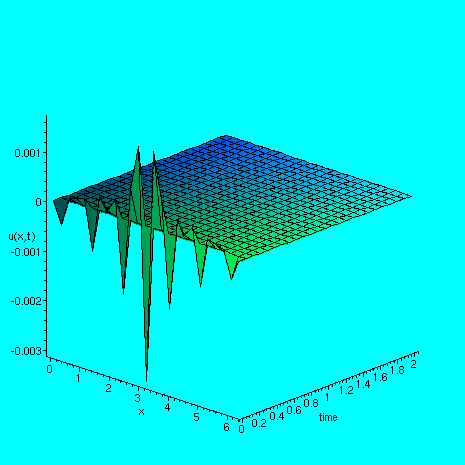 |
Math
300 A1
Advanced Boundary Value Problems Fall 2005 MWF 1300 -1350 V128 |
Dr. Thomas Hillen Associate Professor phone: 492-3395 e-mail: thillen@ualberta.ca University of Alberta Department of Mathematical and Statistical Sciences |
|||||||||||||||||||||||||||||||||||||||||||||||||||||||||||||||||||
Assignments
|
|||||||||||||||||||||||||||||||||||||||||||||||||||||||||||||||||||||
Link to G. Swaters' section: : http://pacific.math.ualberta.ca/gordon/teaching/300.html Link to Math 300 from last year.:, where we used a different textbook. |
|||||||||||||||||||||||||||||||||||||||||||||||||||||||||||||||||||||
Course Notes: (These are the notes as I prepared them for
this course. During the lecture I might decide for pedagocical reasons
to modify the exposition.)
1. Introduction2. The one-dimensional heat equation(2.1), (2.2) Diffusion equation, (2.3) Boundary conditions (PDF) (2.4) Maximum principle and uniqueness (PDF) (2.5) Steady States (PDF) Convergence to steady state (Maple)
3. The one-dimensional wave equation(3.1), (3.2) Wave equation, (3.3) Boundary conditions (PDF) (3.4) Conservation of energy (PDF) (3.5) Method of Characteristics (PDF) Examples 1 and 3 . html (3.6) D'Alembert's solution (html) Example 1 . hmtl
4. Essentials of Fourier series(4.1), (4.2) Linear Algebra (html) (4.3) The space of piecewise smooth functions (pdf) (4.3) continued(html), Example1(Maple) , (4.3) continued(html) Example2(Maple), Example 3 (Maple)
5. Separation of variables I(5.3) Separation of variables for the heat/diffusion equation, (5.3) continued, Example1(maple), Example2(maple) (5.4) Separation of variables for the wave equation, Example1(maple) (5.5) The multi-dimensional spatial problem
6. Calculus of Fourier series(6.1), (6.2), (6.3) Differentiation of Fourier series (6.4) Integration of Fourier Series (6.5) The Gibbs Phenomenon
7. Separation of variables II(7.2) Nonhomogeneous Equations (7.3) Nonhomogeneous Boundary Conditions (7.4) Nonhomogeneous Equation and Nonhomogemeous Boundary Conditions Example: Notes, Maple 8. Sturm-Liouville eigenvalue problems(8.1), (8.2) Regular Sturm-Liouville eigenvalue problem (8.4) Generalized Fourier series solutions
10. Classical PDE problems(10.2) Laplace equation in polar coordinates (10.2) continued and (10.3) Thin Beam From: G. de Vries, T. Hillen, M. Lewis, J. Mueller, B. Schoenfisch, A Course in Mathematical Biology, SIAM, 2006.: * Special Unit on Reaction-Diffusion Equations * * Special Unit on 2x2 Systems of ODEs *
11. Transform Methods(11.2) The Fourier
Integral Example(maple)
|
|||||||||||||||||||||||||||||||||||||||||||||||||||||||||||||||||||||
OutlineInstructor: Dr. Thomas Hillen, phone: 492-3395, email: thillen@ualberta.ca Office: CAB 575 Office hours: Wednesday 3-5 PM, Thurs- 3-5 PM, or by appointment.
Text:M.K. Keane, A very applied first course in Partial Differential Equations, Prentice Hall, New Jersey, 2002.
Web-page:www.math.ualberta.ca/~thillen/math300-F05/math300.html I will use WebCT for grading. Syllabus:Introduction to partial differential equations; classification into parabolic, elliptic, hyperbolic; boundary conditions; the heat-equation, the diffusion equation, the Laplace equation and the wave equation; method of characteristics; separation of variables; Fourier series solutions; Sturm--Liouville eigenvalue problems; Fourier transform methods; applications.
Tentative Schedule:
Grading:
Deferred Exam: January 14, 900-1200, most likely in CAB 243 (but the location might change) No calculators are allowed during the exams. There will be no marks for class participation or in class presentations.
Homework:There will be 6 homework assignments of equal weight. The assignments
are due on Fridays at 1PM in the assignment box,
third
floor in CAB. No late assignments will be accepted. I encourage
you to work in teams of two. If you work in teams of two it will not be considered as dishonesty or
cheating (see last item of the outline). But each student
has to hand in all solutions. Grading Scheme:I will use the following scheme as recommended by the University of Alberta for a third year course: A+(6%), A(8%), A-(10%), B+(11%), B(16%), B-(15%), C+(13%), C(7%), C-(5%), D+(3%), D(3%), F(3%) I reserve the right to adjust the scale upwards, as to give better grades.
Policies:Policy about course outlines can be found in Section 23.4(2) of the University Calendar.
Academic honesty:The University of Alberta is committed to the highest standards of academic integrity and honesty. Students are expected to be familiar with these standards regarding academic honesty and to uphold the policies of the University in this respect. Students are particularly urged to familiarize themselves with the provisions of the Code of Student Behavior (online at www.ualberta.ca/secretariat/appeals.htm) and avoid any behavior which could potentially result in suspicions of cheating, plagiarism, misinterpretation of facts and/or participation in an offence. Academic dishonesty is a serious offence and can result in suspension or expulsion from the University.
Help: The Department of
Mathematical & Statistical Sciences runs a free "walk-in" math help
clinic every week day from 9am until 3pm in ED 751. |
|||||||||||||||||||||||||||||||||||||||||||||||||||||||||||||||||||||